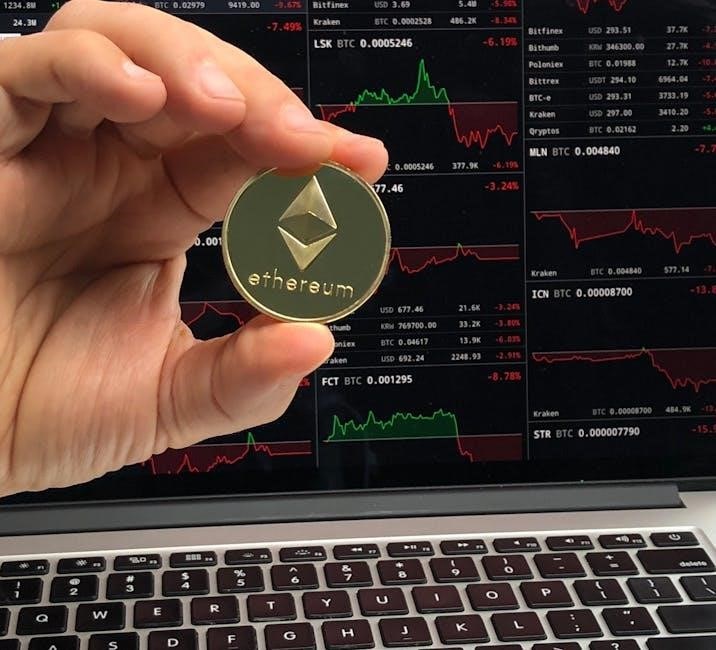Option Greeks are essential tools for traders, measuring the sensitivity of options prices to various factors like price changes, volatility, and time decay. They include Delta, Gamma, Theta, Vega, and Rho, each providing unique insights into risk and potential returns. Understanding these metrics is crucial for developing and executing effective trading strategies, allowing traders to anticipate and manage risks more effectively. This guide explores their roles, importance, and practical applications in modern trading.
1.1 What Are Option Greeks?
Option Greeks are financial metrics that measure the sensitivity of an option’s price to various factors. They include Delta, Gamma, Theta, Vega, and Rho. Delta measures the change in an option’s price per unit change in the underlying asset’s price. Gamma measures the rate of change of Delta. Theta reflects the impact of time decay on option value. Vega measures sensitivity to changes in volatility, while Rho measures the effect of interest rate changes. These metrics provide traders with insights into how external factors influence option prices, enabling better risk management and strategy execution. Understanding Greeks is fundamental for traders to assess potential risks and opportunities in options trading.
1.2 Importance of Greeks in Options Trading

Option Greeks are vital for traders as they provide insights into how external factors influence option prices. Delta helps anticipate price movements, while Gamma highlights the stability of Delta. Theta reveals time decay impacts, crucial for short-term strategies. Vega measures volatility sensitivity, essential for predicting price swings, and Rho shows interest rate effects. These metrics enable traders to assess risks, optimize portfolios, and execute strategies effectively. By understanding Greeks, traders can make informed decisions, hedge positions, and maximize profits; They are indispensable tools for both novice and experienced traders, offering a deeper understanding of market dynamics and enhancing overall trading performance in volatile markets.

Understanding the Key Greeks
Option Greeks—Delta, Gamma, Theta, Vega, and Rho—measure how option prices react to changes in price, volatility, time, and interest rates, guiding traders in risk assessment and strategy execution.
2.1 Delta: Measuring Price Sensitivity
Delta measures the sensitivity of an option’s price to changes in the underlying asset’s price. A Delta of 0.5 means the option’s price moves $0.50 for every $1 change in the asset. Positive Delta indicates a call option, while negative Delta signifies a put option. Traders use Delta to gauge potential profits and manage portfolio risk. High Delta options are more volatile, while low Delta options are more stable. Understanding Delta is crucial for hedging and strategy implementation, helping traders anticipate price movements and adjust positions accordingly. It is a fundamental metric in options trading strategies, essential for both beginners and professionals.
2.2 Gamma: The Rate of Change of Delta
Gamma measures the rate of change of Delta, indicating how much Delta changes with a $1 move in the underlying asset’s price. High Gamma means Delta changes rapidly, while low Gamma means Delta remains relatively stable. Gamma is highest for at-the-money options and decreases as options become deeply in or out of the money. It is also higher for shorter-term options. Traders monitor Gamma to anticipate potential Delta shifts, allowing them to adjust positions and manage risk effectively. Understanding Gamma is crucial for strategies like Gamma scalping, where traders profit from buying and selling options as Delta fluctuates. Gamma is a key metric for assessing the volatility of Delta and its impact on trading outcomes.
2.3 Theta: Understanding Time Decay
Theta represents the rate at which an option’s value decreases due to the passage of time. It is the measure of time decay, quantifying how much an option loses value as time progresses. Long options positions are negatively impacted by Theta, as their value erodes over time. Conversely, short positions benefit from Theta, as the options they sold lose value. Theta is highest for at-the-money options and accelerates in the final weeks before expiration. Traders use Theta to manage time-sensitive strategies, such as credit spreads or iron condors, aiming to maximize the decay of extrinsic value; Understanding Theta is essential for balancing risk and reward in options trading, especially for those employing time-based strategies.
2.4 Vega: Measuring Volatility Sensitivity
Vega measures the sensitivity of an option’s price to changes in implied volatility. It indicates how much an option’s value will change for a one-point shift in volatility; Higher Vega values mean the option is more sensitive to volatility changes. Vega is crucial for traders employing strategies like straddles or strangles, which rely on volatility spikes. Unlike Delta, Vega is not directionally biased, making it a key metric for volatility trading. Traders use Vega to hedge against or capitalize on expected changes in market volatility. Understanding Vega is essential for managing risks and optimizing strategies in volatile markets, where pricing fluctuations can significantly impact option values and trading outcomes.

2.5 Rho: The Impact of Interest Rates
Rho measures the sensitivity of an option’s price to changes in interest rates. It quantifies how much the option’s value will change for a 1% shift in interest rates. Rho is particularly relevant for longer-dated options, as interest rates have a more significant impact over time. While less volatile compared to other Greeks, Rho plays a crucial role in strategies involving debt financing or in environments with fluctuating interest rates. Traders use Rho to assess potential risks and opportunities arising from interest rate changes, allowing them to adjust their portfolios accordingly. Understanding Rho is vital for maintaining accurate risk assessments and optimizing trading strategies in varying economic conditions.

Advanced Greek-Based Strategies
Advanced Greek-based strategies leverage Delta, Gamma, Theta, and Vega for sophisticated trading. Techniques like Delta-Neutral Trading, Gamma Scalping, and Theta Decay help traders manage risks and optimize returns effectively.
3.1 Delta-Neutral Trading
Delta-Neutral Trading is a strategy that balances the overall Delta of a portfolio to zero, minimizing exposure to directional price movements. By combining long and short positions, traders offset potential losses or gains from small price fluctuations. This approach is particularly useful for market makers and traders seeking to manage risk while capitalizing on other factors like time decay or volatility. Delta-Neutral strategies often involve options and underlying assets, ensuring the portfolio remains insensitive to price changes. Adjustments are made by adding or subtracting positions to maintain equilibrium. This method is ideal for those aiming to profit from non-directional market movements while controlling overall portfolio risk effectively. Resources like “Trading Option Greeks” provide detailed insights into implementing such strategies.
3.2 Gamma Scalping: Maximizing Profits
Gamma Scalping is an advanced trading strategy that leverages the Gamma metric to capitalize on frequent, small price movements of an underlying asset. Traders profit by repeatedly buying and selling options as the asset’s price fluctuates, capturing the premium collected from these transactions. This strategy thrives in high-volatility environments, where Gamma values are elevated, allowing for more significant gains. By maintaining a Delta-neutral position, traders minimize directional risk while maximizing returns from time decay and volatility. Resources like Dan Passarelli’s “Trading Option Greeks” provide detailed strategies for implementing Gamma Scalping effectively, emphasizing its potential to generate consistent profits in dynamic markets.
3.3 Theta Decay Strategies: Managing Time
Theta Decay Strategies focus on capitalizing on the time decay of options, a key aspect of volatility trading. These strategies exploit the predictable decline in option value as expiration approaches, particularly for out-of-the-money contracts. Traders often sell options with high Theta values to collect premiums, which diminish over time. Resources like “Options Greeks Cheat Sheet” and Dan Passarelli’s insights highlight the importance of monitoring Theta to manage risk. By maintaining a Delta-neutral position, traders can profit from time decay while minimizing exposure to price movements. This approach is ideal for stable markets, where volatility is low, and the erosion of extrinsic value accelerates, ensuring steady returns through systematic premium collection.
3.4 Volatility Trading with Vega

Vega measures an option’s sensitivity to changes in implied volatility, a critical factor in volatility trading strategies. Traders use Vega to predict how option prices will react to shifts in market volatility. High Vega values indicate greater responsiveness to volatility changes, making these options ideal for strategies like straddles or strangles. Resources such as the “Options Greeks Cheat Sheet” and Dan Passarelli’s insights emphasize Vega’s role in identifying profitable opportunities. By buying options with high Vega in anticipation of increased volatility or selling them when expecting calm markets, traders can capitalize on these fluctuations. Webinars and guides further explain Vega’s application, ensuring traders can effectively harness its power in their strategies, as outlined in detailed PDF materials on Greek-based trading approaches.

Risk Management Using Greeks
Greeks help traders manage risk by measuring sensitivity to price, volatility, and time changes. Strategies like Delta-neutral trading and Gamma scalping enable effective risk mitigation, ensuring balanced portfolios and controlled exposure to market fluctuations. Educational resources, such as the “Options Greeks Cheat Sheet” and Bloomberg Press books, provide detailed guidance on these techniques, empowering traders to make informed decisions and protect their investments while optimizing returns. These tools are essential for both novices and professionals aiming to master risk management in options trading, as highlighted in various PDF guides and webinars on Greek-based strategies.
4.1 Hedging Strategies with Greeks
Hedging strategies with Greeks involve using Delta, Gamma, and other metrics to offset potential losses. Delta-neutral trading, for instance, balances directional risk by pairing options and underlying assets. Gamma scalping exploits the convexity of options, while Theta decay strategies manage time-related risks. Vega-based hedging addresses volatility exposure, ensuring portfolios remain resilient to market fluctuations. These techniques, detailed in resources like the “Options Greeks Cheat Sheet,” allow traders to neutralize risks systematically. By understanding how Greeks interact, traders can create robust hedges, protecting investments while maintaining potential for profit. Such strategies are essential for managing complex options positions effectively, as outlined in various PDF guides and webinars on Greek-based trading.
4.2 Portfolio Optimization Techniques
Portfolio optimization using Greeks involves balancing and refining positions to align with trading objectives. Delta-neutral strategies minimize directional risk, while Gamma scalping capitalizes on price fluctuations. Theta decay strategies manage time-related erosion, and Vega-based adjustments mitigate volatility exposure. Rho considerations address interest rate impacts. By analyzing these metrics, traders can systematically adjust portfolios to enhance returns or reduce risks. Resources like the “Options Greeks Cheat Sheet” offer practical insights, emphasizing how Greeks empower traders to tailor strategies effectively, ensuring alignment with market conditions and investor goals. These techniques, as detailed in various PDF guides, are integral to advanced options trading and portfolio management.
Case Studies and Examples
Real-world applications of Greek strategies are illustrated through practical examples, such as Delta-neutral trading and Gamma scalping. These case studies demonstrate how traders effectively manage risk and maximize profits using option Greeks, providing actionable insights for implementing these strategies in live markets.
5.1 Real-World Applications of Greek Strategies
Real-world applications of Greek strategies demonstrate their practical value in managing risk and maximizing returns. For instance, Delta-neutral trading involves balancing delta exposure to minimize directional risk, while Gamma scalping capitalizes on rapid price movements. Theta decay strategies, such as selling options, exploit time degradation of option value. Vega-focused approaches, like volatility trading, allow traders to profit from market uncertainty. These strategies are often combined, such as using iron condors or straddles, to create tailored risk-reward profiles. By analyzing case studies, traders can see how Greeks are applied in live markets, enabling better portfolio management and more informed decision-making. These examples highlight the versatility and effectiveness of Greek-based trading techniques in various market conditions.
Mastering Option Greeks is crucial for effective trading. Explore resources like the “Options Greeks Cheat Sheet PDF” and advanced guides from Bloomberg Press for deeper insights and practical strategies to enhance your trading skills and portfolio management.
6.1 Resources for Further Learning
For deeper insights, explore the “Options Greeks Cheat Sheet PDF,” offering a comprehensive overview of Delta, Gamma, Theta, Vega, and Rho. Dan Passarelli’s “Trading Option Greeks” provides advanced strategies, while Bloomberg Press books cover practical applications. Webinars and guides like “Essential Option Strategies” explain complex concepts with examples. These resources help traders master volatility trading, time decay, and risk management, ensuring a solid foundation for executing Greek-based strategies effectively.
